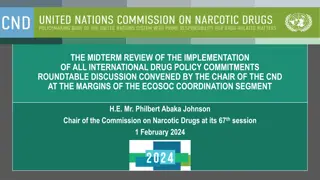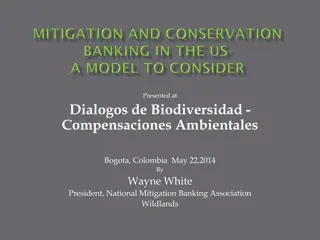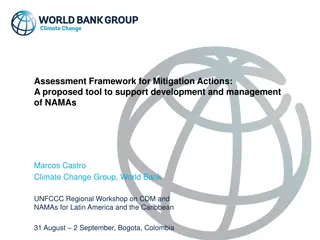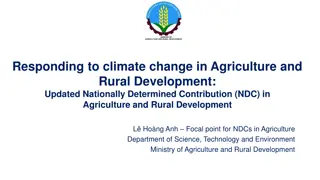Tracking Progress of NDC Mitigation Commitments
This content emphasizes the importance of tracking progress in implementing and achieving Nationally Determined Contributions (NDCs). It discusses the necessary information, indicators, methodologies, and parameters involved in monitoring NDC targets, including GHG emissions, LULUCF sector contributions, ITMOs, and mitigation co-benefits. The process involves identifying, compiling, and reporting on NDC indicators step by step to assess targets effectively.
Download Presentation

Please find below an Image/Link to download the presentation.
The content on the website is provided AS IS for your information and personal use only. It may not be sold, licensed, or shared on other websites without obtaining consent from the author.If you encounter any issues during the download, it is possible that the publisher has removed the file from their server.
You are allowed to download the files provided on this website for personal or commercial use, subject to the condition that they are used lawfully. All files are the property of their respective owners.
The content on the website is provided AS IS for your information and personal use only. It may not be sold, licensed, or shared on other websites without obtaining consent from the author.
E N D
Presentation Transcript
Tracking Progress of the Mitigation Commitments of Nationally Determined Contributions (NDCs) Dominic Sheldon Senior Consultant Climate Action Planning and Transparency Ricardo Energy and Environment Definition of NDC indicators
Reporting information on tracking progress of NDCs C. Information necessary to track progress made in implementing and achieving NDCs Each Party shall identify indicator(s) (quantitative or qualitative; relevant to the NDC) to track progress towards implementation and achievement of its NDC Each Party shall provide: the information for each selected indicator for the reference point(s), level(s), baseline(s), base year(s); and the most recent information for each reporting year; and compare these description of each methodology and accounting approach used for its NDC target, construction of baseline, and each indicator identified; [key parameters, assumptions, definitions, data sources, models, IPPC guidelines, metrics, etc] all this information in a structured summary to track progress: Information on indicators [reference level; most recent; at the reporting years in between] GHG emissions and removals consistent with the scope of its NDC, where applicable; Contribution from the LULUCF sector for each year of the target period or target year, as applicable; Information on use of ITMOs, as applicable; Each Party with an NDC that consists mitigation co-benefits from adaptation actions and economic diversification plans, shall provide information on domestic policies and measures implemented to address social and economic consequences of response measures.
Identifying and compiling NDC indicators - Step by step approach Step 3 Step 4 Identify data and methodology required Step 5 Compile, report, document, archive Step 1 Identify and assess NDC targets Step 2 Make targets SMART Identify type of indicator suitable to track the target
Step 1: Identify and assess NDC targets What to do. As a starting point, identify all mitigation and adaptation targets included in the most recent NDC. List them in a tabular format, including The target or effort. The target value (if quantitative) or description (if qualitative). The scope of the target or effort (e.g., sectors, gases). The unit of the target value (if quantitative). The target timeframe. The baseline value (if available).
Step 1: Identify and assess NDC targets - GHG related targets Target value Target timeframe Value in reference / Base period / BAU NDC target type Country Examples Scope Target unit CO2, CH4, N2O, perfluorocarbon s (PFCs), hydrofluorocarb ons (HFCs) and SF6 Absolute emission reduction or limitation target relative to a base year Brazil NDC commits to reduce its greenhouse gas emissions in 2025 by 37%, compared with 2005 . Base year emission estimation in the fourth BUR is around 2.4 Mio. kt of CO2 eq. May be updated according to the latest inventory. 37 % 2025 Morocco s NDC unconditional) reduction target, 18.3% below BAU emissions by 2030 . Emission reduction target below a BAU level CO2, CH4, N2O and HFCs The BAU scenario is projected approx. 1.4 Mio. kt CO2 eq in 2030 18.3 % 2030 Argentina s s fixed-level target, will not exceed net emissions of 359 Mt CO2 eq by 2030 to 369 Mt CO2 eq for 2030. No reference value is used. But in its NDC submission Argentina compares the level of ambition to its 2016 emissions, which were around 364 Mt CO2 eq. CO2, CH4, N2O, HFCs and PFCs Fixed-level target 359 Mt CO2 eq 2030
Step 1: Identify and assess NDC targets Non-GHG related targets Value in reference / Base period / BAU NDC target type Target timeframe Country Examples Scope Target value Target unit China has pledged to increase the share of non- fossil fuels in primary energy consumption to around 25%. Sectoral non greenhouse gas targets N/A 25 % 2030 N/A Bangladesh aims to implement renewable energy projects, enhance efficiency of existing power plants, improve technology for power generation. Mitigation actions Implementation of actions N/A MW 2030 N/A
Step 1: Identify and assess NDC targets Adaptation targets Target value / Qualitative description Target timeframe Sector/focus Country Examples Target unit Expand the scope of Brazil s National Drinking Water Quality Surveillance Program (VIGIAGUA) to reach 85% of Brazilian municipalities, by 2019. Engagement with 85% of Brazilian municipalities Water Quality % 2019 Fiji to promote the enforcement of appropriate national building codes and infrastructure design on critical facilities and public assets. Kenya to up-scale and promote drought tolerant traditional high value crops; water harvesting for crop production; index-based weather insurance; conservation agriculture; agro-forestry; and Integrated soil fertility management. Enforcement of national building codes to support compliance of disaster resilient infrastructure Human Settlement N/A 2030 Implementation of disaster resilient agricultural techniques and management Agriculture N/A 2030
Step 2: Make targets SMART What to do. Assess and, if necessary, clarify the scope covered by the target. Where necessary, clarify also other elements, e.g., units, reference / baseline levels. This is a relevant prerequisite to constructing relevant indicators in the following step. The more general targets are defined, the more work will be required. In doing so, involve the stakeholders who will be responsible for implementing the measures necessary to achieve the targets.
Step 2: Make targets SMART S M A R T Specific Measurable Ambitious Relevant Time-bound The indicator is clearly defined, so there cannot be different interpretation s of it The indicator value can be measured quantitatively or qualitatively The indicator relates to a relevant impact of a mitigation action Achieving the target requires ambitious action The indicator relates to a point in time of timeframe
Step 2: Make targets SMART Achieving a share of 28% of renewable power by 2030 To increase public awareness of climate changes effects and impacts on general health
Step 2: Make targets SMART E.g. Share of power generation incl. or excl. imports and exports? Measurable Measurable What does a share of 28% refer to? E.g. Share of capacities installed? Achieving a share of 28% of renewable power by 2030 Specific Which technologies should be counted as renewable power technologies? Solar PV Wind Hydro Nuclear Biofuels S M A R T
Step 2: Make targets SMART Specific Measurable 28% of total installed capacity of electricity generation to be renewable sources (wind, solar and hydro) by 2030 Specific Time-bound S M A R T
Step 2: Make targets SMART Measurable Specific Time-bound Ambitious Has a timeframe been established for when the target must be reached? What are the current levels of public awareness, have these been defined? What mechanism will be used to engage with the public? To increase public awareness of climate changes effects and impacts on general health Under which conditions will public awareness be considered as increased? What types of climate change impacts will be addressed? What types of climate change impacts will be addressed? Specific Measurable Ambitious Measurable Measurable Relevant S M A R T
Step 2: Make targets SMART Time-bound Specific To develop and implement the Climate Change Education Programme (CCEP) by 2025 aimed at increasing public understanding of the specific effects of climate change on respiratory and cardiovascular health, demonstrated by a 20% increase in public knowledge as measured through pre- and post- campaign surveys. Measurable Relevant S M A R T
Step 3: Identify type of indicator suitable to track the target What to do. Once the NDC targets have been made SMART, identify indicators which allow understanding whether these targets have been met or not. - With quantitative targets, once they are made SMART, the most relevant indicator can be identified from the target itself. - With qualitative targets the intervention logic framework (Logframe) provides a helpful approach to identifying suitable progress indicators. Further indicators, e.g., related to implementation, could of course be chosen to support the understanding of progress, e.g., afforested surface area, area for which forest management plans have been improved, etc. The MPGs leave the choice of indicators to the Parties, as long as the indicators are relevant to their NDC. The use of such implementation-related progress indicators can surely be considered beneficial at the national level. Parties might however decide not to include such information in their BTRs.
Step 2: Make targets SMART Mitigation targets issues GHG related targets Type of mitigation target Elements to consider for a SMART target Unit Absolute emission reduction or limitation target relative to a base year Base year clearly agreed? Gases included agreed? kt CO2eq Sectors / GHG inventory categories agreed Target year agreed? As for absolute emission reduction target Emission reduction target below a BAU level % BAU level clearly defined? Data and methods available? kt CO2 eq / capita or GDP / etc. As for absolute emission reduction target Intensity target used clearly defined, e.g., GDP, population? Intensity-relevant factor and source / methodology to be % (if compared to BAU or base period)
Step 2: Make targets SMART Mitigation targets issues Non-GHG related target Type of mitigation target Elements to consider for a SMART target Unit Definition of renewable to be used e.g., which sources, which technologies? % GWh Renewable Energy What does it relate to share in total power / power + heat generated, GWh electricity generated, renewable generation capacities installed / operational? MW - - Definition of energy efficiency to be used GWh What does the target relate to, e.g. energy efficiency improvement compared to a base year or BAU Energy efficiency target level? Energy Efficiency TJ / unit of GDP Hectares or km2 Is there a national forest definition? % of national territory Forest cover Methodology to determine forest cover agreed? Reference level / baseline data and methodology available? % increase compared to reference / baseline
Step 3: Identify type of indicator suitable to track the target What to do. Once the NDC targets have been made SMART, identify indicators which allow understanding whether these targets have been met or not. - With quantitative targets, once they are made SMART, the most relevant indicator can be identified from the target itself. - With qualitative targets the intervention logic framework (Logframe) provides a helpful approach to identifying suitable progress indicators. Further indicators, e.g., related to implementation, could of course be chosen to support the understanding of progress, e.g., afforested surface area, area for which forest management plans have been improved, etc. The MPGs leave the choice of indicators to the Parties, as long as the indicators are relevant to their NDC. The use of such implementation-related progress indicators can surely be considered beneficial at the national level. Parties might however decide not to include such information in their BTRs.
Step 3: Identify type of indicator suitable to track the target GHG target Type of mitigation target Relevant indicators Unit GHG emissions as reported in the national GHG inventory adapted to the specific scope of the target (e.g., gases and sectors covered), including use of market-based mechanisms, and adapted to the specific timeframe of the target (e.g., where a multi-year target- period applies). Absolute emission reduction or limitation target relative to a base year kt CO2eq Relationship (e.g., difference in %) between GHG emissions in the BAU target year / period (updated, where applicable) and Emission reduction target below a BAU level GHG emissions as reported in the national GHG inventory adapted to the specific scope of the target (e.g., gases and sectors covered), including use of market- based mechanisms, and adapted to the specific timeframe of the target (e.g., where a multi-year target-period applies) % GHG emissions in all years leading to the current year, as reported in the national GHG inventory adapted to the specific scope of the target (e.g., gases and sectors covered), including use of market-based mechanisms Peaking Target kt CO2 eq
Step 3: Indicator type Developing a logical framework Action Output Outcome Impact Introduction of new water management tools for sustainable agriculture Increase in productivity and crop yields Increase in production leads to more profits for farmers to expand and less strain on water resources Increased number of farmers adopting sustainable methods Indicators Number of farmers adopting improved water management Levels of economic water scarcity* Increase in yields
Step 3: Identify type of indicator suitable to track the target Non-GHG target Type of mitigation target Relevant indicators Unit Depending on specific definition of target, relevant indicators include % of electricity generated by source Total generation by source Installed capacity by source % GWh Renewable Energy MW Depending on specific definition of target, relevant indicators include Total energy demand or consumption Energy intensity of the economy GWh Energy Efficiency TJ / unit of GDP Depending on specific definition of target, relevant indicators include Share of land covered by forest Area covered by forest Area restored or reforested Forest stock CO2 sequestered per year % ha ha m3 Forest cover t CO2eq
Step 4: Identify data and methodology required What to do. Once indicators have been defined, identify the data and methodology required to compile the indicator. For each indicator, a data collection plan needs to be developed. This will provide a complete overview for each indicator of what is being measured, the baseline, the targets, data sources and methods. It also specifies who will be collecting data, with what frequency and to whom it will be reported. In the case of NDC indicators, much relevant information or sometimes even the indicator data itself is likely to be already available from data collection for the compilation of other sections of the BTR. What Who When Where Why
Step 4: Identify data and methodology required In considering the data and potential methodology required, the following questions might be helpful: 1. What information is required for the indicator? 2. Where can that information be found has it already been compiled for other purposes, e.g., national statistics, SDG reporting? 3. For which years is the information available? 4. Does the information available have the necessary quality, e.g., is the approach to data collection / calculation consistent over time, is the data sufficiently accurate? 5. Is the information already available with the correct scope and in the correct units? Or are adjustments to scope / units necessary? 6. Is a calculation necessary to compile the indicator (e.g., GHG emissions, GHG emission reductions or removals?) If so, is there an internationally accepted practice that should be used, e.g. the 2006 IPCC Guidelines for National GHG Inventories, the World Resource Institute Policy and Action Standard, Progress indicators for mitigation and/or adaptation actions as agreed for reporting to donors.
Step 4: Identify data and methodology required GHG target Mitigation target categories Relevant data sources Absolute emission reduction or limitation target relative to a base year National GHG inventory data from the BTR under preparation National GHG inventory data from the BTR under preparation Emission reduction target below a BAU level BAU projections from the most recent NDC or from the BTR under preparation in case the BAU projections are updated over time Peaking Target National GHG inventory data from the BTR under preparation National GHG inventory data from the BTR under preparation Intensity target Depending on specific target: GDP, population typically available from the national statistical offices
Step 4: Identify data and methodology required Non-GHG target Mitigation target categories Relevant data sources Depending on specific target: % of electricity generated by source and/or total generation by source Renewable Energy from the national energy balance (if available ), likely collected for the mitigation chapter of the BTR under preparation Installed capacity by source: Potentially collected for the mitigation chapter of the BTR under preparation, alternatively to be collected from the Ministry responsible for power and heat generation Total energy demand or consumption: from the national energy balance (if available), potentially collected for the mitigation chapter of the BTR under preparation Energy Efficiency Energy intensity of the economy: Potentially available from the national statistical services. Depending on type of target information like: - - - - - % of land covered by forest Hectares of land covered by forest Hectares of land restored or reforested Forest cover Volume of forest stock Tonnes of CO2 stored/sequestered per year Has likely been collected for the preparation of the LULUCF categories of the national GHG inventory and potentially for the mitigation and/or adaptation chapters. Implementation of qualitative policies and measures Information likely available from the mitigation chapter of the BTR under preparation.
Step 4: Identify data and methodology required Adaptation target Adaptation target areas Relevant data sources Depending on specific target: Volume of water (m3) can be derived from sector analysis this may have been collected as part of the NAP and/or national water provider Water Depending on specific target: National totals of species can be potentially sourced from Ministries of Environment, Environmental Protection Agencies and National Biodiversity Statistics Ecosystems and biodiversity Depending on specific target: National Statistical Offices and/ or Disaster Management Agencies Extreme events and disasters Severe Weather Database Depending on specific target: Health Statistics National Hydrometeorological Institutes Human settlements and environmental health Ministry of Health Depending on specific target: Data on agricultural production can be collected through agricultural surveys organized by the national statistical agencies International: WHO Mortality database Agriculture and forestry Geospatial data/remote sensing from the ministry or agency responsible for agriculture
Step 5: Compiling, reporting, documenting, archiving What to do. The assessment of available data sources in the previous step will show that many progress indicators can be compiled with data already available from BTRs and National Communications (NCs). The timing when such data, e.g., national GHG inventory estimates, information on adaptation actions, becomes available will be important to consider for the overall BTR compilation process. Where additional data needs to be collected, assess whether such data collection can be integrated into existing data collection processes or can be built up together with data collection processes which need to be established for BTR reporting. Prioritise and select data accordingly Improve data quality over time Build on existing data / structures Collect data Fill data gaps
Step 5: Compiling, reporting, documenting, archiving Data gaps Type of data gap What to do What to report in the BTR Report the fact that the indicator data is currently not available and why that is the case Identify activities enabling the collection of relevant data (e.g., research, studies, new statistics) Relevant input data not available at all action taken to make the indicator data available in the future entities responsible for these activities When you expect to be able to report on the indicator necessary preconditions, e.g., budget / staff, legal framework, MoUs, etc. What international support is required to do so (if applicable) Report, Where possible, use gap-filling approaches (e.g., overlap, surrogate data, interpolation, and trend extrapolation) to estimate the indicator value for the full scope / all relevant years what information was not available / for which years? What gap filling approaches have been deployed? Relevant input data not available for all years, all sectors, all regions, etc. actions taken to make indicator data available in the future When would you expect to be able to report the indicator? Use approaches suggested under relevant input data not available at all to collect missing data in the future What international support is required to do so (if applicable)? Data is not available as a relevant mitigation or adaptation action has not started yet Report Put data collection and compilation processes in place before the action starts The fact that the implementation has not yet started and When it is planned to start?
Examples of Rwanda's mitigation indicators Supporting Indicator Generation of electricity (GWh and % of total) Sector Headline Indicator Other Factors Energy (Electricity generation) Share of renewables in total electricity supply (%) Rural Energy Strategy development (progress towards milestones) Current fossil fuel use (% of total energy use) Number of Electric Vehicles Availability and cost of new and low carbon energy technologies and practices Energy Substitution of F-gases and progress towards targets under Kigali amendment to Montreal Protocol Current GHG emissions (Mt CO2 eq) F-gas substitution (%) IPPU AFOLU (agriculture) Crop production (t of total crop biomass) Climatic and other key factors influencing yields and agricultural practices Crop rotation (ha) Waste recycling progress (e.g., policies and practices; plastic, metals and paper recycling rates) Waste to energy generation (MW) Waste Current total waste disposal (t)
Examples of Rwandas adaptation indicators Adaptation Indicator Data source Percentage change in national climate change vulnerability index (%) Vulnerability Index study report Water storage per capita & number of households and institutions with a rainwater harvesting system installed (m3 per capita) Integrated Water Resources Management & Water Monitoring and Development Unit Rwanda Water and Forestry Authority & Forestry department-GIS Report Proportion of land surface covered by forest (ha) Percentage of extreme weather events for which advance warning was provided at least 30 min in advance (%) Rwanda Meteo, Quarterly high impact weather report
Identifying and compiling NDC indicators - Step by step approach Step 1: Identify and assess NDC targets Step 4: Identify data and methodology required What to do: Identify mitigation and adaptation targets in NDC. List targets in a tabular format with relevant details Identifying data and methodology. Determine what information is required, its availability, and quality. Check if adjustments to scope or units are necessary. Identify if calculations are needed and what methodologies to use Step 2: Make targets SMART What to do: Clarify scope, units, reference/baseline levels. Involve stakeholders responsible for implementing measures Step 5: Compiling, reporting, documenting, archiving Compiling and reporting. Assess integration of data collection with existing processes. Plan long- term improvements for data quality and availability. Step 3: Identify type of indicator suitable to track the target What to do: Identify indicators for quantitative and qualitative targets. Implementation-related progress indicators beneficial at the national level. Parties might not include such information in their BTRs Document all relevant information for future compilation. Learn from national GHG inventory and statistical offices' processes
Identifying and compiling NDC indicators - Step by step approach - EXERCISE Step 1: Identify and assess NDC targets Step 4: Identify data and methodology required Determine what information is required, from whom, its availability, and quality. What to do: Identify mitigation and adaptation targets in YOUR NDC Step 5: Compiling, reporting, documenting, archiving GHG, non-GHG, adaptation Assess integration of data collection with existing processes. Step 2: Make targets SMART Plan long-term improvements for data quality and availability. What to do: Is the target SMART? Step 3: Identify type of indicator suitable to track the target Document all relevant information for future compilation. Learn from national GHG inventory and statistical offices' processes What to do: Identify indicators for quantitative and qualitative targets
Exercise Target? Specific Measurable Ambitious Relevant Time-bound Is it SMART? Yes No Yes No Yes Reformulate target














